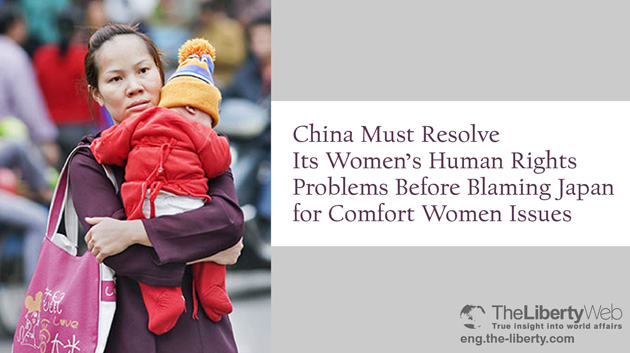China Must Resolve Its Women’s Human Rights Problems Before Blaming Japan for Comfort Women Issues
China has recently decided to scrap its one-child policy to halt the rapid aging of the population and the declining birth rate, allowing all married couples to have two children. It is wrong that a state controls how many children a family can have. This time, we will report the facts about the various human rights abuses that China’s one-child policy has caused.
From 1950 to 1960, the Chinese government introduced pro-natalist policies under the slogan of “Give birth to a lot of children and increase the population,” causing a sharp increase in the population. Then, it had to face various issues like famine resulting from the population explosion, and introduced a one-child policy in 1979 when it adopted reforms and market-opening policies. Families that followed the one-child policy could receive various benefits, but those who went against the rule and had more than one child were heavily fined.
Human Rights Abuses Caused by China’s One-Child Policy
In some areas, the introduction of the one-child policy caused various human rights abuses against women such as forced abortion or sterilization, which drew international criticism.
Moreover, if additional children were born to parents that had already had a first child, the new babies were called heihaizi or “black children”, and were not permitted to register in the national household registration system. It is estimated that there are tens of millions of, or one hundred million, heihaizis. Those children have been denied access to education and healthcare, and have not officially been able to marry, which has forced them to live hard lives.
The Chinese authority has also adopted a duel household registration system called “hukou” under which urban and rural residents are registered separately, preventing migrant workers from pouring into cities. In poor rural areas that cannot enjoy the benefits of the economic development of China’s cities, many families prefer a boy child because he can carry on the family name. With the spread of prenatal diagnosis by ultrasonography, the number of female fetuses aborted has increased. Consequently, the sex ratio at birth in China is 118 boys to 100 girls whereas the global gender ratio at birth is 103~107 boys to 100 girls, which means China has a high number of male births. At the end of 2014, China had 33.8 million more males than females.
The Scarcity of Women Results in Marriage Abduction
The effect of gender imbalance among newborns is seen in unexpected places.
For example, it is pointed out that the high share of males has led to the spread of HIV infection through prostitution. Moreover, a shortage of brides has led to the trafficking of women. Gangs have been kidnapping women in countries like Russia, Mongolia, North Korea, Burma, and Vietnam, and selling them to men in “bachelor villages” in China, forcing them into marriage. An American-Chinese journalist, Gordon G. Chang, also wrote about this issue in the October 29th issue of the National Interest.
When the UNESCO panel conducted its final deliberation in October over the Memory of the World registry, China accused Japan of “comfort women issues”, but there is no evidence that the Japanese Imperial Army forcibly and systematically recruited women as comfort women during the war. China must resolve its ongoing women’s human rights abuses and other human rights problems of its own making.
In today’s China, people are being put under government surveillance and the freedom they can get is nothing but “freedom in prison”. The Chinese Communist Party should learn the fundamental idea that the government exists to realize the happiness of the people.



















